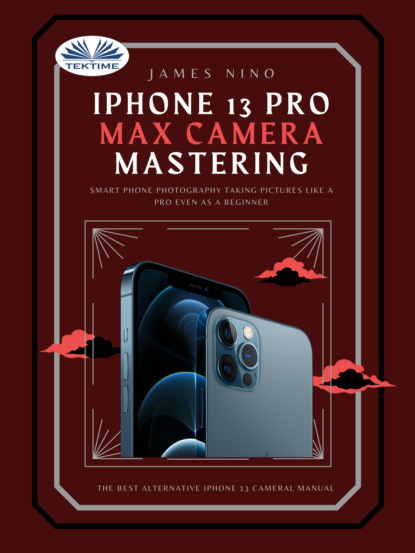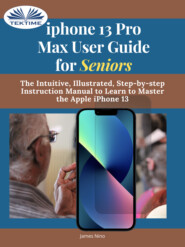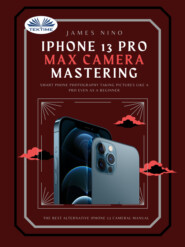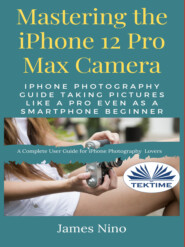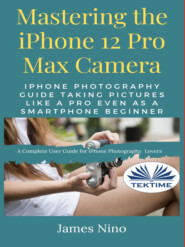По всем вопросам обращайтесь на: info@litportal.ru
(©) 2003-2025.
✖
IPhone 13 Pro Max Camera Mastering
Автор
Год написания книги
2021
Настройки чтения
Размер шрифта
Высота строк
Поля
1 Quality vs. Quantity: It's easy to get lost in the sea of pixels when you're viewing a high-resolution photo or video. However, the size of each pixel matters.
The size of each pixel is measured and represented with μm, which stands for microns; however, smaller amounts with greater size mean better image quality because they have fewer colors per unit area that can be displayed on the screen at any given time - leading us towards higher resolutions!
For example, 1mm has about four times as many color combinations available as 0.8μm does.
1 A 108MP is equal to 12MP: iPhone Pro Max's 12MP camera takes the same pictures as 108MP in low light conditions. A 108MP camera has a more significant number of pixels, but the actual size of them is low.
It means that these higher megapixel cameras capture less light. Hence, they bind multiple pixels to make a single pixel. It means 9 pixels act as a single pixel.
If you do the math, then 9x12=108. Hence, a 108MP camera is equal to a 12MP camera of your iPhone 13 Max.
1 More battery life low processing times: A fewer pixels means less data to process overall than higher megapixels. It results in extended battery life and lower processing times. Because in the end, this is a phone that a user has to do a lot of things with and not just capture images and make videos.
It does not mean that 108MP cameras are utterly useless; they have their advantages and use cases. However, the 12MP camera in iPhone 13 Pro Max is adequate for users, at least until these phones' computational powers and battery life are not increased to a level where these cameras are supportable.
Part One:
Chapter 3: Getting Started
Following extensive research into cinematography and the full utilization of rack focus, the new Cinematic mode on the iPhone helps you record videos of people, objects, and pets with a gorgeous depth effect.
Moreover, the automatic focus changes, allowing anyone to capture cinema-style moments, even if they aren't professional filmmakers. Users can modify the degree of bokeh they want even in the iMovie for iOS and as well as the Photos app. It will soon be available in iMovie for Final Cut Pro5 and macOS. Hence, it makes the iPhone 13 Pro Max one of the few devices capable of editing the depth-of-field effect in the video after recording.
The Cinematic mode for iPhone 13 Pro Max is capable of recording videos in Dolby Vision HDR. Most of which is due to A15 Bionic and sophisticated machine learning algorithms. Both versions also enable HDR video recording with Dolby Vision - from capturing, editing, and sharing - with all of it in 4K up to 60 fps. The faster Neural Engine powers All-new features in the iPhone 13 Pro Max with A15 Bionic.
Photographic Styles enable users to apply their unique picture preferences to each image while still using Apple's multi-frame image processing. Pre-set and personalized choices operate across scenes and subjects. Unlike a primary filter, automatically apply the correct modifications to different image sections to ensure vital features, such as skin tones, are retained.
The dual-camera setup and computational photography capabilities allow Smart HDR 4 to have enhanced color, lighting, and contrast for each subject in a group shot.
Moreover, this is predominantly used in difficult lighting situations, making photos more true-to-life and an upgraded Night mode. And the TrueDepth camera is compatible with all the excellent new camera capabilities, such as Cinematic mode, Smart HDR 4, Photographic Styles, and others.
Chapter 4: Camera Modes
Photo Mode: This is the default photo mode that will be enabled when you open the camera app. To capture a picture, you just have to press the Shutter button (White Circle icon). After which, you can adjust options like Live Photos, flash, timer, and so much more by pressing on the arrow key on top of the screen.
QuickTake: Simply press and hold the Shutter button while in Photo Mode to record a QuickTake movie. To stop recording, release the button.
Burst Mode: Simply press and hold the Shutter button while in Photo Mode and slide the Shutter button to the left and keep it there to shoot a burst of shots, then let go to stop.
Portrait Mode: The camera generates a depth-of-field effect while in Portrait mode, allowing you to shoot images with a crisp focus on your subject along with a blurred backdrop.
Swipe to Portrait mode in the Camera app.
Follow the instructions on your screen. When Portrait mode is on, the name of the lighting effect, for example, Natural Light, turns yellow.
Press the Shutter button.
When you're incredibly close, incredibly far from the subject, or in a dark location, the Camera app will automatically alert you. In addition, you may utilize True Tone flash, set a timer, and apply filters. After taking a photo, you may use the built-in editing capabilities to trim and auto-enhance it.
After taking a picture in Portrait mode, you may change the amount of background or foreground blur and the intensity of the Portrait Lighting effects. Here's how it works:
Select a Portrait mode photo from your library or open the camera in this mode.
Tap Edit, then the Portrait Lighting or Depth of control buttons at the top of the screen to modify Portrait Lighting or Depth of control. A slider displays beneath the image.
To change the effect, move the slider to the left or right. A grey dot above the slider indicates the original value for the photo.
Tap on Done.
Here is how to remove the Portrait mode effect:
1 Choose the photo you wish to alter.
2 Select Edit.
3 At the top of your screen, choose Portrait.
4 Tap on Done.
If you change your mind and wish to re-apply the Portrait mode effect, return to Edit and press Portrait once more.
Low Light Mode/Night Mode: When the camera detects a low-light environment, night mode is activated automatically. When the function is enabled, the Night mode symbol at the top of the screen turns yellow. Depending on the darkness of the environment, your iPhone may take a few seconds or several minutes to shoot a Night mode shot. You may also change the exposure setting.
Square Mode: To shoot films with longer interval frames in low-light settings, utilize Night mode Time-lapse with a tripod. Open the Camera app, then scroll to the far left until Time-lapse appears.
To record your video, press the Shutter button. Live Photos and the flash are disabled while your iPhone is in Night mode. These functionalities can be enabled manually.
Do account for this by using the flash or Live Photos disables Night mode. When you set the Flash to Auto, it will turn on automatically in low-light conditions. Click on the arrow over the viewfinder to manually activate the flash. Then you need to press the Flash button, which appears below the viewfinder, and then toggle it On.
Panorama Mode: Sometimes, a scene is simply too large to capture in a single photograph. Using the iPhone's Panorama function, you may capture space. However, moving objects usually ruin the pictures, so make sure to capture stationary objects. Here is how to capture images in Panorama mode:
1 Open the Camera app.
2 Change to Panorama mode. Scroll your finger down the phone's bottom bar until it says "PANO." Panorama Mode is activated. You may take the shot with either the front or back camera.
3 Determine the course of action. You'll take the panorama photo and simply moving your phone left or right to capture the full scene. The camera will prompt you to move right by default, but you may change this by tapping the arrow.
4 Start the shoot. To start the panorama shot, press the Shutter button. Move the camera horizontally down the route shown on your screen slowly. Keep your phone stable and at the same level throughout.
Video Mode: Use the Camera app to record movies and switch between settings to capture slow-motion and time-lapse footage on your iPhone. Select Video mode. To begin recording, tap the Record button or click either volume button. You may do the following while recording:
To take a still photo, press the white Shutter button.
You can Zoom in and out by pinching the screen.
Press and hold the 1x icon, then drag the slider to the left for more exact zoom options that are present in your iPhone 13 Max Pro.
To stop recording, tap the Record button or touch either volume button. Video is recorded at 30 frames per second by default (fps). Other frame rates and video resolution choices are available under Settings > Camera > Record Video. Depending on your iPhone 13 Pro Max model, the frame rates and resolutions differ. Larger video files arise from higher frame rates and greater resolutions.





